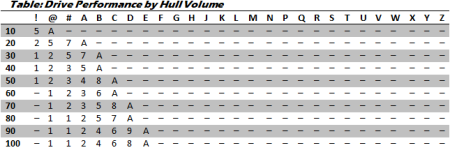Spinward Flow
SOC-14 5K
I'm not sure we're doing the same thing here.If I had my notes handy, I could work out the point below which the combination would put out less than 1EP.
In my example, the drives are fixed for tonnage and cost (so a drive-A is a drive-A regardless of what you install it into) ... it's just the performance that changes (as demonstrated above). The flipside to that is that a power plant-A drive will ALWAYS produce 2 EP, while a power plant-B will ALWAYS produce 4 EP (and so on and so forth up to power plant-Z producing 48 EP). Whether or not a small craft actually USES all of that EP output is a different question ... at which point power down rules can come into play.
So a 30 ton Ship's Boat with a 6G maneuver drive (drive-A) will need 1.8 EP to achieve Agility=6 (because 30/100*6=1.8).
A power plant-A standard drive will produce (up to) 2 EP ... however, absent weapons and computer, only up to 1.8 EP are required for Agility 6 maneuvering. This then means that the power plant could be "powered down" to deliver only 1.8 EP (90% of max power) full time as a matter of routine operating procedure and thus only require 1.8 tons of fuel per 28 days because of 1.8 EP required to maneuver at full agility.
The point being that you can always "use less power" than a power plant is capable of generating.
Using "more power" than a power plant is capable of generating (temporarily) is a matter of Emergency Agility
If you want to create (house) rules for how long Emergency Agility can be used for, I would recommend


